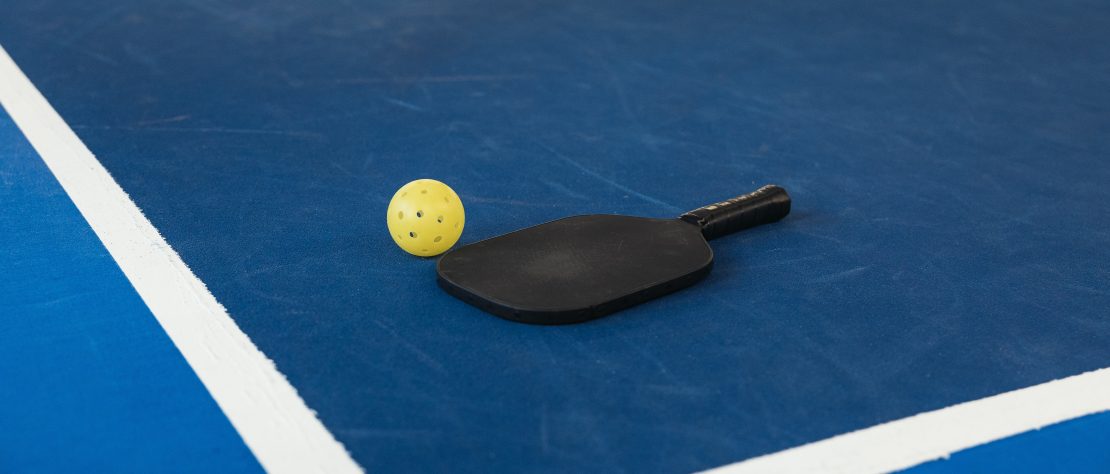Pickleball is big in the United States and growing in popularity elsewhere. If you’re not yet familiar with this sport, here is an insight into what it is, and how you can get set for Pickleball.
What is pickleball?
Pickleball is a sport that combines elements of tennis, badminton, and table tennis. It is played with a solid paddle and a perforated plastic ball, similar to a wiffle ball. It is played on a court similar in size to a badminton court and uses a modified tennis net. The game can be played as singles (one player on each side) or doubles (two players on each side).
The game is known for its simplicity, making it accessible to people of all ages and skill levels. It can be played at a recreational level in backyards or community centers, as well as at a competitive level in organized leagues and tournaments. Pickleball has gained popularity worldwide due to its ease of learning, social nature, and the ability to be played both indoors and outdoors.
What are the rules of the game?
The objective of the game is to hit the ball over the net and land it within the boundaries of the opponent’s side of the court. The ball must clear the net and the opposing team then returns the ball back and the rally continues until a point is scored.
Here are the basic rules and scoring methods for pickleball:
- Court. Pickleball is played on a smaller court than tennis, and similar in size to a badminton court. It can be played indoors or outdoors. The court is divided into left and right service areas, and there is a non-volley zone extending either side of the net.
- Serving. The serving team must start from the right-hand side of the court and serve the ball diagonally to the opponent’s service court. The serve must clear the non-volley zone and land within the opposite diagonal court. Only one serve attempt is allowed, and the serve must be underhand.
- Double Bounce Rule. After the serve, the defending side must let the ball bounce first before it can be returned, and subsequently the servicing side also has to let the ball bounce. Once the ball has bounced on both sides, players can then either play a volley or a groundstroke.
- Non-Volley Zone. Players cannot volley the ball while standing inside the non-volley zone. They can enter the zone but must step back outside the zone to hit a volley. The non-volley zone prevents players from hitting smashes close to the net, encouraging more strategic play.
- Scoring. Only the serving team can score points. A point is scored if the defending side doesn’t return a ball, hits the ball out the court, does not let the serve ball bounce, or volleys in the non volley zone. When a team scores a point, the same person continues to serve. When the serve is lost the service goes to the opponent and they begin their service.
- Result. The first team to reach 11 points and with a two-point advantage wins the game. Matches are usually best of three games.
- Doubles. In doubles play, the serving team’s players rotate sides each time they win a point, with the player in the right-hand court always serving first. This rotation ensures that both players get opportunities to serve and receive.
It’s worth noting that while the basic rules mentioned above are generally followed, there may be variations in rules and regulations depending on the organization, level of play, or specific tournament rules.
What are the potential health benefits of playing pickleball?
Playing pickleball offers several health benefits. Here are some ways in which it could positively impact your health.
- Cardiovascular Fitness. Pickleball involves constant movement, including running, lunging, and quick changes in direction. These aerobic activities help improve cardiovascular health, increase stamina, and enhance overall fitness levels.
- Weight Management. Pickleball is a physically demanding sport that burns calories. Regular participation can contribute to weight loss or weight management goals, as it helps in reducing body fat and building lean muscle mass.
- Improved Coordination. The game requires hand-eye coordination, agility, and precise timing. Regularly playing pickleball can enhance your coordination skills, leading to better reflexes and motor control.
- Muscle Strength. Pickleball involves weight-bearing movements, such as jumping and pivoting, which can help strengthen muscles.
- Joint Health. The low-impact nature of pickleball, compared to high-impact sports like running or basketball, puts less stress on the joints. It is generally easier on the knees, hips, and ankles, making it an excellent option for individuals looking for a lower-impact activity.
- Balance and Stability. Pickleball requires quick movements, changes in direction, and maintaining balance while hitting the ball. Regular play can improve balance and stability, which is particularly beneficial for older adults in reducing the risk of falls and improving overall stability.
- Social Interaction. Pickleball is often played in doubles, encouraging social interaction and fostering a sense of community. Engaging in social activities like pickleball can have positive mental health benefits, including reducing stress and enhancing overall well-being.
It’s important to note that the intensity and level of physical activity in pickleball can vary depending on factors such as skill level, playing style, and competitiveness.
As with any physical activity, it’s recommended to consult with a healthcare professional before starting a new exercise regimen, especially if you have any underlying health conditions or concerns.
Find out more about Pickleball:
Interested in further inspiration for gaining fitness? Take a look at our posts on calisthenics and martial arts.
Photo credit: Mason Tuttle / Pexels
